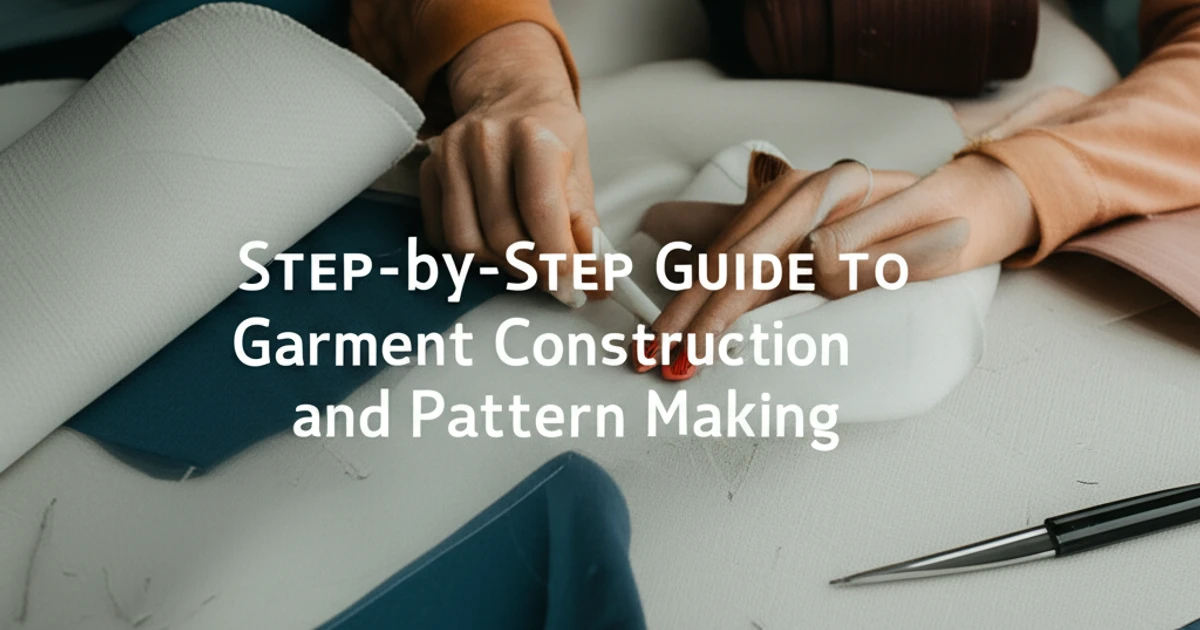From Sketch Garment Construction to Stitch: Your Blueprint to Bringing Fashion to Life
Have you ever looked at a beautiful garment, perhaps a flowing dress or a perfectly tailored jacket, and wondered, “How did they *do* that?” Beyond the initial spark of an idea or a captivating sketch, there lies a profound journey – one of precision, patience, and a surprising amount of magic. It’s the journey from a flat piece of paper to a three-dimensional form, a transformation that breathes life into your creative vision. For every aspiring designer, every dedicated fashion student, and every beginner eager to create, mastering the fundamentals of garment construction and pattern making isn’t just a skill; it’s the very foundation upon which your design dreams will stand.
As a blogger passionate about demystifying the art of fashion creation, I’ve walked this path myself, experiencing the triumphs of a perfectly sewn seam and the frustrations of a pattern piece that just wouldn’t lie flat. My goal here is to guide you through this essential process, offering a comprehensive step-by-step garment construction and pattern making guide that will not only inform but also inspire. Think of this as your personal fashion design tutorial, designed to empower you to turn imagination into tangible, wearable art. Let’s embark on this exciting creative adventure together, understanding how every cut, every line, and every stitch contributes to the final masterpiece.
What’s the First Whisper of a Garment? (Pattern Making Unveiled)
Before a single piece of fabric is touched, before a needle glints under the light, every garment begins its life as a pattern. Imagine your most inspired design sketch – a riot of lines and colors, a dream taking shape on paper. Now, how do you translate that beautiful, two-dimensional vision into something that wraps around a human form? This is where the crucial skill of pattern making comes into play. It’s the architectural blueprint of your design, a precise map that dictates every curve, every seam, and every proportion. Without a well-drafted pattern, even the most exquisite fabric and skilled sewing can’t rescue a design.
For many, the idea of drafting patterns can seem daunting, a world of rulers, curves, and mathematical precision. But at its heart, a pattern making guide begins with understanding basic blocks, or slopers. These are fundamental, fitted patterns for standard body parts – a bodice block, a skirt block, a sleeve block. I remember my first attempt at drafting a sleeve block; it felt like wrestling with an octopus! But gradually, as I understood how to measure, how to draw the curves, and how these flat pieces would fold into a 3D shape, a profound understanding clicked. These basic blocks are your starting point, your canvas, and mastering them is the first vital step in bringing your designs to life, allowing you to confidently move beyond simple alterations and into true creation.
Can Paper Truly Predict Fabric? (The Art of Pattern Manipulation)
Once you have your basic blocks, the real creativity of pattern making begins: manipulation. This is where your unique design vision truly takes form. Do you want a dramatic full skirt from a simple straight block? Perhaps a flattering princess seam on a basic bodice? The art of pattern manipulation involves techniques like dart rotation, slash and spread, adding design ease, and pivoting – methods that allow you to transform those foundational blocks into an endless array of styles. It’s like having a magical clay that you can mold into any shape, all while ensuring it still fits beautifully.
Understanding how to manipulate patterns is central to any effective fashion design tutorial. It’s about foreseeing how a line on paper will translate into the drape and fit of the fabric. For instance, rotating a dart can shift fullness from the waist to the bust, creating a sophisticated cowl neck. Slashing and spreading a pattern piece can add volume for a dramatic sleeve or a voluminous skirt. This isn’t just about moving lines; it’s about predicting the dance of the fabric, how it will fall, how it will shape the body. My personal “aha!” moment came when I realized how a simple pivot could transform a basic sleeve into a graceful bell sleeve – it was like discovering a secret language that allowed me to speak to the fabric itself. This mastery is what truly elevates a fashion student guide from basic sewing to genuine design.
Where Does the Magic Materialize? (Fabric Selection & Preparation)
With your meticulously drafted and manipulated pattern ready, the spotlight shifts to your chosen medium: fabric. The textile you select isn’t just a covering; it’s an integral character in your design story, dictating drape, structure, and overall aesthetic. Will your design be crisp and architectural in a heavy twill, or flowing and ethereal in a silk chiffon? This choice is critical. Even the most perfectly constructed garment can fall flat if the fabric doesn’t align with the design’s intent. Pay attention to weight, weave, fiber content, and how it interacts with light and movement.
Before you even think about cutting, proper fabric preparation is non-negotiable for successful step-by-step garment construction. Most fabrics need to be pre-shrunk by washing and drying them exactly as the finished garment will be treated. This prevents nasty surprises later, like a perfectly fitting dress suddenly shrinking after its first wash. After washing, a thorough pressing ensures your fabric is flat and wrinkle-free, which is absolutely vital for accurate cutting. I once skipped this step in my early days, confident my eye was good enough. The result? A decidedly lopsided skirt that taught me the hard way that respect for the fabric’s grainline and proper preparation are paramount. Take your time here; it sets the stage for a smooth and successful project.
What Tools Are Your Allies in This Craft? (Essential Toolkit & Setup)
Just as a painter needs brushes and an easel, a fashion creator needs a dedicated set of tools. Investing in quality essentials will not only make your journey easier but also yield more professional results. At the heart of your kit should be a sharp pair of fabric shears (never use them on paper!), a reliable pair of paper scissors for patterns, a flexible measuring tape, and a good selection of pins. You’ll also need marking tools like tailor’s chalk or fabric pens, a seam ripper (every sewer’s best friend!), and of course, a sewing machine. Don’t underestimate the power of a good iron and ironing board – pressing is a garment construction superpower.
Beyond the handheld tools, your workspace matters. A dedicated, clutter-free space, even a small corner, with good lighting, makes a world of difference. It allows you to spread out your pattern pieces, lay your fabric flat, and maneuver your sewing machine without frustration. Think of your tools as extensions of your creativity. Learning to use them properly is part of the fashion student guide curriculum. From threading your machine confidently to understanding different needle types, each small mastery builds confidence. Embrace your tools; they are the loyal allies that will help you translate your paper dreams into a tangible garment.
How Do Flat Pieces Become a Form? (Step-by-Step Garment Assembly)
Now, for the thrilling part: bringing all those flat pieces together! This is the core of step-by-step garment construction. It starts with meticulously cutting out your fabric pieces according to your pattern, paying close attention to grainlines and notches. After cutting, transfer all pattern markings (darts, pocket placements, buttonholes) to your fabric. These small dots and lines are your internal navigation system during assembly. Next, pin your corresponding fabric pieces right sides together, ensuring edges align perfectly. Many beginners skip basting (temporary hand-stitching), but it can be a lifesaver for tricky fabrics or complex seams, guaranteeing accuracy before you commit with the machine.
Then, the rhythmic hum of your sewing machine begins. Stitch your seams following your pattern’s instructions, always remembering to backstitch at the beginning and end of each seam to secure it. This is where patience and precision truly pay off. After every single seam, *press it*. This step is often overlooked by beginners but is absolutely transformative. Pressing seams open or to one side not only flattens the fabric, making subsequent steps easier, but it also gives your garment a crisp, professional finish that screams “well-made.” I remember the first time I truly committed to pressing every seam; it was like watching a clumsy, homemade attempt suddenly transform into something polished and professional. This attention to detail is a hallmark of any effective fashion design tutorial.
Is It Truly Done When the Last Stitch is Sewn? (Finishing Touches & Refinement)
The garment is taking shape, but the journey isn’t over until the finishing touches are applied. These are the details that elevate a good garment to a great one. Think about the hems – neat, even, and invisible stitches that provide a clean edge. Consider your closures: a perfectly inserted zipper that glides smoothly, or buttonholes that are evenly spaced and cleanly sewn. If your garment is lined, this is where that inner layer meets the outer, providing a beautiful finish and comfort against the skin. These are not merely functional elements; they are opportunities to demonstrate your skill and commitment to quality.
Finally, give your entire garment one last, thorough press. This final act of pressing smooths out any lingering wrinkles, sets the seams, and gives the garment its ultimate, ready-to-wear appearance. Then, try it on! Assess the fit, the drape, and the overall feel. Don’t be afraid to make minor alterations or adjustments. Every garment is a learning experience, and the ability to refine and adapt is a crucial part of your growth as a designer. Holding that finished piece in your hands – a design born from your imagination, brought to life by your own hands through careful garment construction – is an unparalleled feeling of accomplishment.
Your Creative Journey Continues…
The path of step-by-step garment construction and pattern making guide is a continuous learning curve, filled with endless possibilities and new techniques to master. From understanding the nuances of different fabrics to perfecting various seam finishes, each project refines your skills and expands your creative toolkit. Don’t be discouraged by mistakes; view them as invaluable lessons. Every crooked seam or misaligned dart is a stepping stone on your journey to mastery.
My hope is that this fashion design tutorial has ignited a deeper passion within you, providing a clear roadmap for transforming your creative visions into tangible, wearable art. Embrace the process, celebrate every small victory, and remember that with every stitch, you are not just creating a garment – you are crafting your unique voice in the world of fashion. Keep sketching, keep drafting, and most importantly, keep creating! The fashion world awaits your unique touch.


